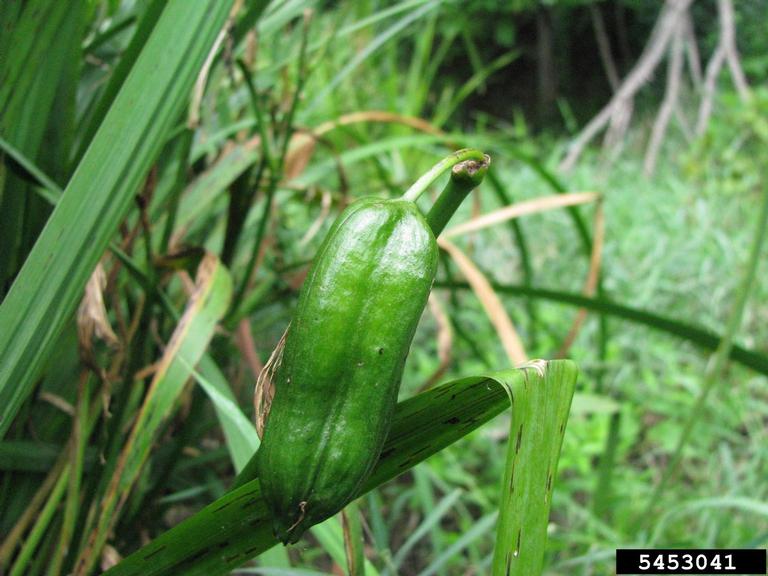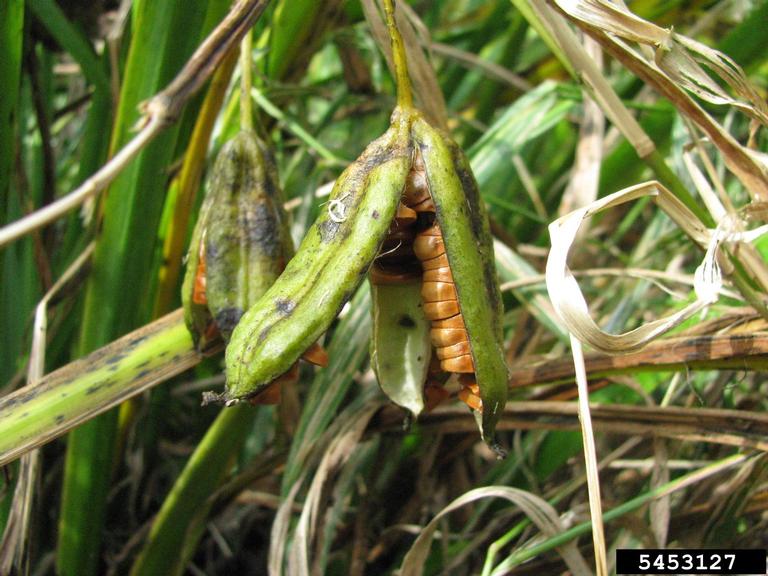Yellow Flag-Iris

Yellow Flag-Iris
(Iris pseudacorus)
Priority: - Contain / Annual Control
Tags: Aquatic | Toxic
Identification and Reproduction
Identification
- Yellow flag iris is a perennial plant that grows in clumps, forming dense mats.
- Stems of individual plants can grow up to 1.5 meters tall.
- Leaves are erect, flattened, sword-like and often dark green. They connect at the base, in a fan-like manner. They begin growing erect but will start to curve.
- Yellow flag iris have distinct large yellow flowers. They can grow upto 10 cm in diameter. They are made up of 6 segments; 3 small erect petals and 3 larger drooping sepals.
- Seeds form in large, glossy green, triangular capsules. The seeds float in water.
Reproduction
- Yellow flag iris reproduces by seed and rhizome fragments.
- Seeds are the primary form of dispersal.
- Seeds can float for extended period of time, often spreading downstream.
Habitat & Ecology
It thrives in wetlands, ponds, marshes, slow-moving streams, roadside ditches. This plant can grow submerged in water that is 25 cm deep. It can withstand salt water and peat conditions.
Impacts
Social:
- Root mats can disrupt irrigation systems and flood control ditches.
- Plants can cause skin irritations and allergies.
- Yellow flag iris is also toxic for human and animal consumption.
Ecological:
- Dense stands will form a mat-like root mass which will reduce water flow in passages.
- They out-compete native vegetation, displacing plants and wildlife species.
- They also compact soils and will elevate topography over time, creating drier conditions.
Management
Mechanical/Manual Control:
- Carefully dig or hand pull in small patches - this must be done for several years to deplete root reserves. Remove entire rhizome mass.
- As a stop gap measure, clip flowers to prevent seed development and dispersal and remove fruits to prevent them from floating downstream and creating new colonies.
- Plant parts are toxic and can cause skin irritation, so be sure to wear gloves and appropriate protective clothing.
- Take care to ensure that all plant parts have been removed from the area and disposed of by burning or placing in a thick garbage bag and take to the landfill.
- The application of a benthic barrier may be used. Cut the plant down to the base and lay down a heavy rubber mat to block light and weigh down rhizomes. See this Youtube Playlist (Yellow Flag Iris - Instructional Videos on Using Benthic Barrier Technique) for further directions
- More information on the use of benthic barriers for yellow flag iris can be found in a Thompson Rivers University Research Report
For alternative planting options to yellow flag iris, check out the ISCBC's Grow Me Instead guide.
Benthic Barriers
A three part series outlining the effective use of benthic barriers to control the aquatic invasive Yellow flag iris
1. The Science behind how the Barriers work
2. Demonstration of a Barrier Installation
3. Assessing when to remove barriers and the consequences of incorrect installation
Overview of tools required for benthic barrier installation
Resources
For further details on Yellow Flag Iris control please refer to the Metro Vancouver Best Management Practices for Yellow Flag Iris (pg. 11-15)
Download the Metro Vancouver Factsheet on Yellow Flag Iris here.
Download the Invasive Species Council of BC's Factsheet for Yellow Flag Iris here.
Header photo (James St. John).






